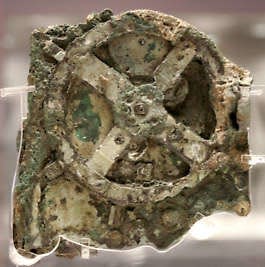Gill: Some parallels between device in new 'Indiana Jones' movie and Newark Earthworks
Pieces of an ancient mechanism are back in the news, thanks to the latest movie starring that fictional archaeologist, Dr. Henry "Indiana" Jones, Jr.
The so-called “Dial of Destiny” that is the fifth installment in the series is loosely in some ways, and very closely in others, based on an actual find of the last century in the Aegean Sea, opposite the island of Kythera, or Antikythera as they called it.

More than 2,000 years ago, a mysterious Greek workshop created an amazing bronze mechanism about the size of a hat box, with gears and a crank. You could set the device to the current date or any future or past date, and see on the analog display where the planets were, when the next Olympic or Pythian games would be held, and even calculate when eclipses would occur, along with more everyday (or every year) events of solstices and equinoxes, and the phases of the moon.
The Antikythera Mechanism was discovered in 1901 in a shipwreck found off the southern coast of Greece that was carrying treasures and attractions to Rome for a parade to honor Julius Caesar. The statuary aboard the ship was the main attraction, and the corroded pieces of bronze gears were considered an anomaly until their possible practical uses were considered in just the last few decades.
Once looked at closely, these linked gears constitute parts of a clockwork device of which a lead scientist said, “This device is extraordinary . . . The astronomy is exactly right . . . in terms of historic and scarcity value, I have to regard this mechanism as being more valuable than the Mona Lisa.”

The device did not point one to fissures in the space-time continuum. Its reality as a means to understand what was known long ago is to me even more interesting, however, and a time machine in its own right.
Built about the same time as the Antikythera Mechanism — and only truly appreciated about the same time as scholars realized what that gadget was really good for — was the geometric complex of earthen enclosures we call the Newark Earthworks. And in many ways, they are two means to the same end.
Not small and compact and metallic, but encompassing more than 4 square miles and made of basket loads of earth, the earthen geometry of the Newark Earthworks was doing for observers in ancient Ohio much the same sort of calculation and prediction and recorded observation they were doing at that time in Greece.
With better metallurgy and some inscriptions, the Antikythera Mechanism could be carried in a knapsack, or on a boat. The Newark Earthworks aren’t portable: you had to come to them, make a pilgrimage of sorts, in order to work the “mechanism” and monitor the places now and upcoming of the sun, the moon, and perhaps other astronomical phenomena as well.
One other interesting parallel: the Antikythera Mechanism is today in about seven fused chunks, two of them big. We don’t have all of it, and those gaps are a challenge to fully understanding what it was for, and how it was used. Likewise, the Newark Earthworks is no longer intact. And while we know mostly the two big pieces (the Great Circle and the Octagon), there are small bits and chunks which help us understand the whole all the better.
My landscape tours, one of which will happen again in October, are a chance to take people around to see how there are “gears” and fragments of the whole complex still hiding in plain sight along the streets and alleys of Newark.
There are also no fissures in time, other than the imagination that takes us back to when the Newark Earthworks were built here 2,000 years ago.
Jeff Gill is a writer, storyteller, and preacher in central Ohio. He leads tours as a volunteer with the Newark Earthworks Center at Ohio State University Newark campus and the Ohio History Connection, and is a World Heritage Ambassador.
This article originally appeared on The Columbus Dispatch: Device focus of new 'Indiana Jones' has parallels to Newark Earthworks
